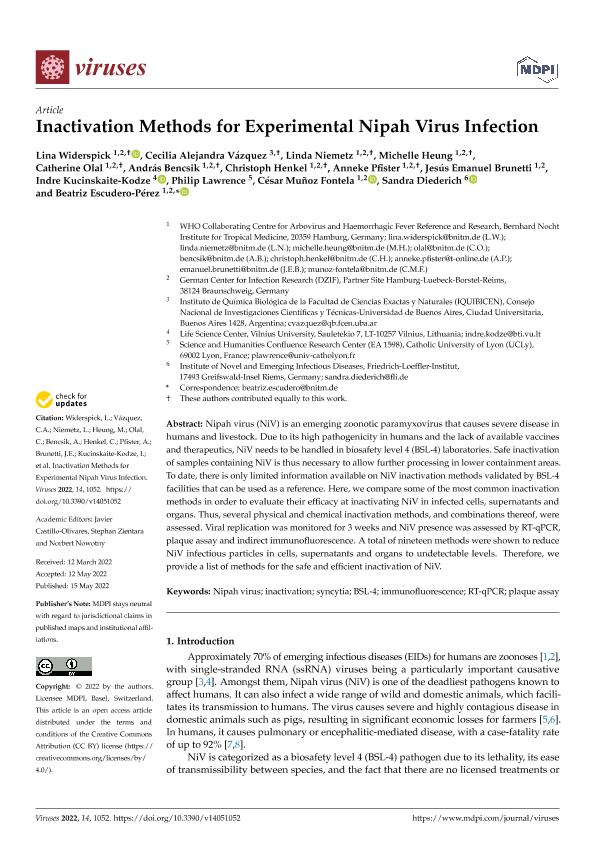Artículo
Inactivation Methods for Experimental Nipah Virus Infection
Widerspick, Lina; Vázquez, Cecilia Alejandra ; Niemetz, Linda; Heung, Michelle; Olal, Catherine; Bencsik, András; Henkel, Christoph; Pfister, Anneke; Brunetti, Jesús Emanuel
; Niemetz, Linda; Heung, Michelle; Olal, Catherine; Bencsik, András; Henkel, Christoph; Pfister, Anneke; Brunetti, Jesús Emanuel ; Kucinskaite Kodze, Indre; Lawrence, Philip; Muñoz Fontela, César; Diederich, Sandra; Escudero Pérez, Beatriz
; Kucinskaite Kodze, Indre; Lawrence, Philip; Muñoz Fontela, César; Diederich, Sandra; Escudero Pérez, Beatriz
 ; Niemetz, Linda; Heung, Michelle; Olal, Catherine; Bencsik, András; Henkel, Christoph; Pfister, Anneke; Brunetti, Jesús Emanuel
; Niemetz, Linda; Heung, Michelle; Olal, Catherine; Bencsik, András; Henkel, Christoph; Pfister, Anneke; Brunetti, Jesús Emanuel ; Kucinskaite Kodze, Indre; Lawrence, Philip; Muñoz Fontela, César; Diederich, Sandra; Escudero Pérez, Beatriz
; Kucinskaite Kodze, Indre; Lawrence, Philip; Muñoz Fontela, César; Diederich, Sandra; Escudero Pérez, Beatriz
Fecha de publicación:
05/2022
Editorial:
MDPI
Revista:
Viruses
ISSN:
1999-4915
Idioma:
Inglés
Tipo de recurso:
Artículo publicado
Clasificación temática:
Resumen
Nipah virus (NiV) is an emerging zoonotic paramyxovirus that causes severe disease in humans and livestock. Due to its high pathogenicity in humans and the lack of available vaccines and therapeutics, NiV needs to be handled in biosafety level 4 (BSL-4) laboratories. Safe inactivation of samples containing NiV is thus necessary to allow further processing in lower containment areas. To date, there is only limited information available on NiV inactivation methods validated by BSL-4 facilities that can be used as a reference. Here, we compare some of the most common inactivation methods in order to evaluate their efficacy at inactivating NiV in infected cells, supernatants and organs. Thus, several physical and chemical inactivation methods, and combinations thereof, were assessed. Viral replication was monitored for 3 weeks and NiV presence was assessed by RT-qPCR, plaque assay and indirect immunofluorescence. A total of nineteen methods were shown to reduce NiV infectious particles in cells, supernatants and organs to undetectable levels. Therefore, we provide a list of methods for the safe and efficient inactivation of NiV.
Palabras clave:
BSL-4
,
IMMUNOFLUORESCENCE
,
INACTIVATION
,
NIPAH VIRUS
,
PLAQUE ASSAY
,
RT-QPCR
,
SYNCYTIA
Archivos asociados
Licencia
Identificadores
Colecciones
Articulos(IQUIBICEN)
Articulos de INSTITUTO DE QUIMICA BIOLOGICA DE LA FACULTAD DE CS. EXACTAS Y NATURALES
Articulos de INSTITUTO DE QUIMICA BIOLOGICA DE LA FACULTAD DE CS. EXACTAS Y NATURALES
Citación
Widerspick, Lina; Vázquez, Cecilia Alejandra; Niemetz, Linda; Heung, Michelle; Olal, Catherine; et al.; Inactivation Methods for Experimental Nipah Virus Infection; MDPI; Viruses; 14; 5; 5-2022; 1-14
Compartir
Altmétricas



